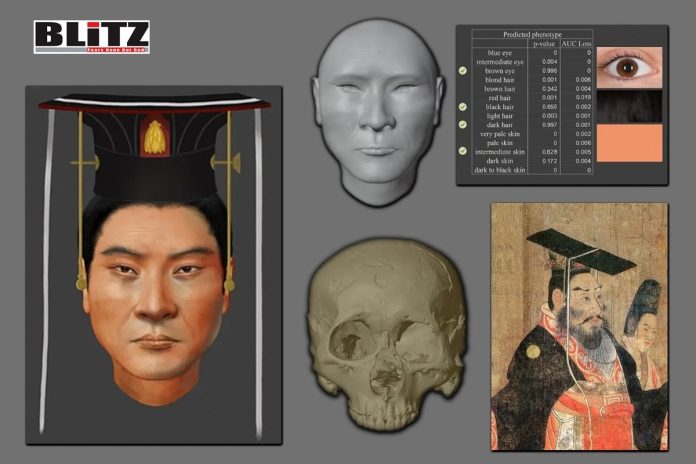In a groundbreaking revelation that promises to reshape our understanding of ancient China’s cultural landscape, the Institute for Archaeological Science at Fudan University, in collaboration with the esteemed Shaanxi Provincial Institute of Archaeology, has unveiled the meticulously reconstructed appearance of Emperor Wu of the Northern Zhou Dynasty (557-581). This unveiling not only sheds new light on the life and times of Emperor Wu, also known as Yuwen Yong, but it also unveils a pivotal moment in Chinese history where ethnic integration and diversity played a central role.
Emperor Wu’s rule serves as a profound symbol of political unity and cultural interchange in northern China. However, the mystery surrounding his premature death at 36 has persisted for centuries. Recent forensic findings point to poisoning as the likely cause, implicating the prolonged consumption of alchemical elixirs. This revelation adds intricate layers to the historical narrative of his era, unveiling the complexities and potential dangers lurking behind the pursuit of longevity through ancient medicinal practices.
The reconstruction of Emperor Wu’s likeness represents a remarkable fusion of modern technological prowess and ancient archaeological methodologies. Through the painstaking analysis of skeletal remains unearthed in a tomb nestled within the ancient city of Xianyang, Shaanxi Province, researchers embarked on a quest to resurrect the physical manifestation of this pivotal historical figure. The reconstructed image paints a vivid portrait of Emperor Wu, depicting him with flowing black hair, a complexion adorned with a sun-kissed hue, and eyes that reflect the warmth of brown-a stark departure from conventional depictions that often relegated individuals of the Xianbei ethnic group to stereotypical features.
The journey to unravel the mysteries surrounding Emperor Wu’s life and death began in 1993, when the Shaanxi Provincial Institute of Archaeology stumbled upon his tomb. Subsequent excavations not only revealed the skeletal remains believed to be those of Emperor Wu but also unearthed an array of artifacts that affirmed his identity and significance in Chinese history. However, it was the utilization of cutting-edge genetic analysis techniques pioneered by Professor Wen Shaoqing and his team at Fudan University’s Institute for Archaeological Science that truly breathed life into Emperor Wu’s visage. By harnessing specialized ancient DNA capture probes, the researchers were able to extract approximately 1 million genetic loci from the skeletal samples, enabling the recreation of crucial features such as hair color, skin tone, and even iris hue-a feat that required six years of tireless dedication and meticulous craftsmanship.
“Through the annals of history, a tapestry of ethnicities and cultures intertwines, weaving a narrative of diversity and integration,” remarked Professor Wen Shaoqing. “Emperor Wu’s lineage, with its potential ties to the Han group through his grandmother, exemplifies the dynamic process of multi-ethnic integration that shaped ancient China.”
The recreation of Emperor Wu’s visage stands not just as a tribute to his personal imprint but as a window into the intricate tapestry of ethnic amalgamation in Chinese history. Professor Han Sheng, of Fudan University’s Department of History, astutely observes that the Northern and Southern Dynasties era marked a transformative juncture. It was a time when diverse ethnic groups intermingled, contributing to a cultural synthesis that endures across the annals of time. This epoch witnessed the convergence of myriad ethnicities, forging a cohesive whole that reverberates through history. The reconstructed likeness of Emperor Wu thus serves not only to honor an individual ruler but also as a testament to the enduring legacy of unity amidst diversity in China’s storied past.
“As we unravel the mysteries of the past, we illuminate the pathways to a deeper understanding of our shared heritage,” remarked Professor Han Sheng. “The reconstruction of Emperor Wu’s likeness serves as a beacon of enlightenment, illuminating the complex interplay of cultures and identities that define the Chinese nation.”
The revelation of Emperor Wu’s likeness goes beyond academic importance, highlighting the transformative power of technological archaeology. This groundbreaking achievement not only reshapes historical narratives but also challenges cultural perceptions. By effectively bridging the gap between ancient and modern eras, it opens avenues for a more comprehensive comprehension of China’s diverse ethnic and cultural heritage. This monumental step forward signifies a testament to the enduring legacy of diversity and integration that remains central to the identity of the Chinese nation. It underscores the significance of embracing nuanced perspectives to honor the rich tapestry of China’s historical and cultural landscape, paving the way for a more inclusive and insightful future.



